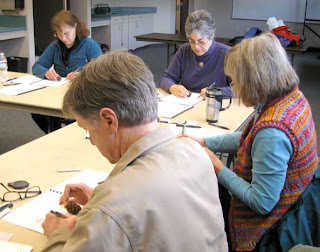 long enough now that I'm starting to get continuing students from previous classes. The Intermediate Nature Sketching class last Sunday was a good example, with three students from previous classes and one new student. There was a real anomaly as well ~ three lefties in the class and only ONE right-handed student! (BTW, the lefties were all returners. Does that mean anything? Naw! Surely not!). There they are in the class photo above, all busily left- and right-handing!
long enough now that I'm starting to get continuing students from previous classes. The Intermediate Nature Sketching class last Sunday was a good example, with three students from previous classes and one new student. There was a real anomaly as well ~ three lefties in the class and only ONE right-handed student! (BTW, the lefties were all returners. Does that mean anything? Naw! Surely not!). There they are in the class photo above, all busily left- and right-handing!It really made me think about how I design my workbooks, because being right handed I have somewhat heedlessly set up the books to be used by right-handers when, with a bit of planning and forethought I can make them equally well-designed for either-handers by, for instance, putting examples ABOVE the area to be drawn in (instead of BESIDE, where they may be covered by a drawing hand)
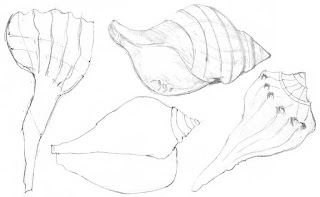 and placing the drawing area in such a way that neither right- nor left-handers have to draw with their hand resting on the plastic comb spine (not really comfortable). It took awhile for that to sink in, but I paid especial attention to it in the upcoming new Nature Sketching With Color workbooks for next weekend. They're not perfect yet, but they are considerably better.
and placing the drawing area in such a way that neither right- nor left-handers have to draw with their hand resting on the plastic comb spine (not really comfortable). It took awhile for that to sink in, but I paid especial attention to it in the upcoming new Nature Sketching With Color workbooks for next weekend. They're not perfect yet, but they are considerably better.DAY 1
The workshop
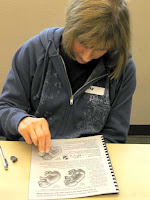 went pretty smoothly considering it was a first run for a couple of things. We warmed up by drawing shells, and since this is an intermediate class I had the students working to use the arc of their hand, and paying particular attention to details of proportion. They did well, as shown in the collection of their shell-drawing efforts above.
went pretty smoothly considering it was a first run for a couple of things. We warmed up by drawing shells, and since this is an intermediate class I had the students working to use the arc of their hand, and paying particular attention to details of proportion. They did well, as shown in the collection of their shell-drawing efforts above.This class
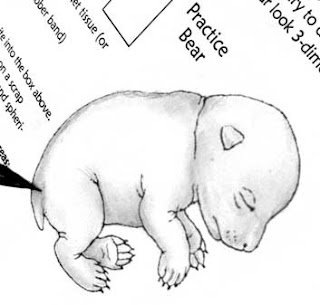 teaches a collection of techniques: how to deal with 3-D shading with regard to cylinders, spheres and planes; seeing and utilizing negative space; a basis for creating realistic leaves, drawing believable eye, and any number of other things.
teaches a collection of techniques: how to deal with 3-D shading with regard to cylinders, spheres and planes; seeing and utilizing negative space; a basis for creating realistic leaves, drawing believable eye, and any number of other things.The workbooks are invaluable for this, as they provide the students with outlines within
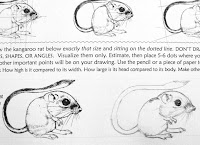 which to work on specific skills. Sure, the students could draw the outlines to work inside, but that would take up a large percentage of the time allotted for the exercise, and they wouldn't learn nearly as much.
which to work on specific skills. Sure, the students could draw the outlines to work inside, but that would take up a large percentage of the time allotted for the exercise, and they wouldn't learn nearly as much. 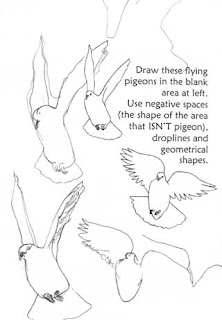 I've never gotten any complaints from students about having to work inside these outlines, so I think they are filling their purpose well.
I've never gotten any complaints from students about having to work inside these outlines, so I think they are filling their purpose well.After
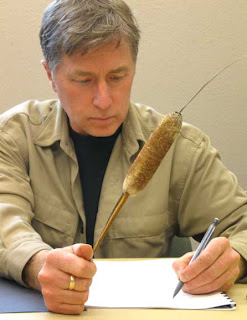 lunch I pulled out my piece d' resistance, the box of cattails which I had so carefully labored to keep from exploding a few weeks ago (see previous post). They made the trip well, and, in fact, survived being taken home and returning with the students without showing any signs of wear.
lunch I pulled out my piece d' resistance, the box of cattails which I had so carefully labored to keep from exploding a few weeks ago (see previous post). They made the trip well, and, in fact, survived being taken home and returning with the students without showing any signs of wear.The cattail project page in the workbook is very
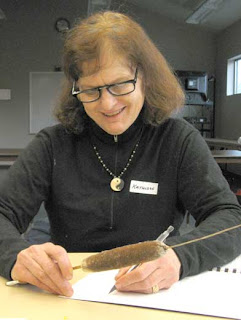 detailed because the students take the cattail home to work on overnight (sometimes they don't have time for homework, but if they do it is much more rewarding and they learn a great deal by trying to puzzle things out for themselves).
detailed because the students take the cattail home to work on overnight (sometimes they don't have time for homework, but if they do it is much more rewarding and they learn a great deal by trying to puzzle things out for themselves).We worked on the cattails an hour in class ~ I did a drawing right alongside them so that I could show them ways to work on the texture and shading.
Part of the homework assignment was to add some fluff to the cattail in the drawing, using a reference photo in the workbook of a partially exploded cattail.
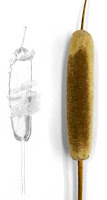


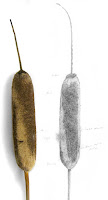 An exploding cattail picture is more visually interesting, and I wanted them to get some practice combining photo-reference material with a sketch. Be sure to click on the images to see a larger version of how they worked out the problem. In order at left are:
An exploding cattail picture is more visually interesting, and I wanted them to get some practice combining photo-reference material with a sketch. Be sure to click on the images to see a larger version of how they worked out the problem. In order at left are: 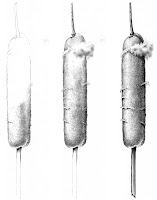 Jan's, Lynns, Kathleen's and Randy's cattails. Nice, huh?
Jan's, Lynns, Kathleen's and Randy's cattails. Nice, huh?That evening, I finished my cattail, too, scanning it into Photoshop during the process, then taking the series to class the next morning so the students could see how I worked out the problems. That's the 3-step series at right.
DAY 2
We
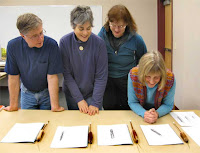 critiqued the cattails as soon as everyone had arrived the next morning, discussing the problems they ran into with the fluff. (I had let them deal with that without much instruction in the workbook. Some of my most useful learning sessions have been when I had to piece together how someone else got a certain effect.)
critiqued the cattails as soon as everyone had arrived the next morning, discussing the problems they ran into with the fluff. (I had let them deal with that without much instruction in the workbook. Some of my most useful learning sessions have been when I had to piece together how someone else got a certain effect.)The second day
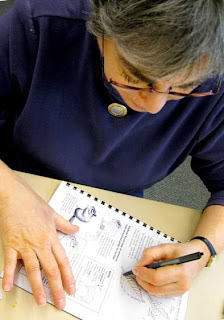 was spent learning how to draw realistic fur on animals, practicing quick ways to rough in a drawing by drawing PAST it then filling in the inner parts
was spent learning how to draw realistic fur on animals, practicing quick ways to rough in a drawing by drawing PAST it then filling in the inner parts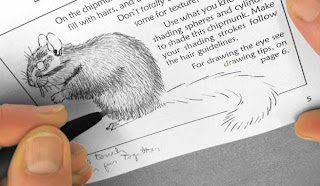 , putting highlights and bounce reflections on eyes and considering how the eye highlights relate to highlights and shadows on spheres, etc.
, putting highlights and bounce reflections on eyes and considering how the eye highlights relate to highlights and shadows on spheres, etc.I had them drawing mostly with ballpoint pen ~ this is useful in forestalling the "sketchy" drawer. Since the lines can't be erased, they don't get made in the first place, leading to a much more "conscious" drawing. And when you're super-conscious of each line you draw, you learn a lot faster.
Because the ballpoint can produce a whole range of tonal values from light gray to black black, it has many of the same drawing qualities as a pencil. After the initial OMG reaction, students often quickly come to prefer it over pencil for sketching (I sure do!). In fact, in the evaluations at the end of the class, Lynn, in response to "What is your favorite medium?" wrote: "pencil, now converting to ballpoint pen!"
After lunch, for our final project, I got out my special effects kit and taught the students how to create white hairs and whiskers against black, then we did the mushroom shown here. They were SO pleased with the results, and so am I.
 One student declared that she's going to do this as a project with her grandson when he comes to visit. Sounds to me like the perfect fun thing for him to do with Granny.
One student declared that she's going to do this as a project with her grandson when he comes to visit. Sounds to me like the perfect fun thing for him to do with Granny.So there is is. A very satisfying workshop for me, and I think for the students, too.
Next weekend

 is my Nature Sketching with Color class. I finished the two workbooks just last week and sent them to bro David, who has already printed and FedExed them back. They should arrive on Monday or Tuesday with enough time for me to write up the detailed class plan schedules I work from.
is my Nature Sketching with Color class. I finished the two workbooks just last week and sent them to bro David, who has already printed and FedExed them back. They should arrive on Monday or Tuesday with enough time for me to write up the detailed class plan schedules I work from.I've tried classes both loosely and tightly structured, and when they're loosely structured the students sometimes don't get a chance to try a technique because we've dallied too long on a previous one.
So I try to keep things moving right along by using the schedule ~ I always know about where in the curriculum I am supposed to be. That's my left brain talking, I guess!
Till next time!

3 comments:
Header looks great- and the class sounds like fun :)
I lived in Jacksonville for 8 years and just returned to Marin Co. last spring. I'm so bummed that I am not nearer for your workshops. Any chance of selling your workbooks on line. I would love the Nature Sketching in Color books.
Elizabeth
Here is my blog..
http://maoma3.blogspot.com
Hi Spinneretta! Thanks for the boost! I'm so pleased it's an improvement!
=====================
Hi Elizabeth,
Jacksonville Oregon? We may have passed like ships in the night!
In answer to your question: I don't generally sell the workbooks separately, as they're meant to be accompanied by verbal instruction, white-board and artpad demos and individual coaching. At some point I may flesh them out and sell them as stand-alones, but at the moment I don't think they're ready.
But thanks for your interest. Maybe you'll come up for the Shakespeare Theater or something on one of my workshop weekends. People have done that before, and found it very fulfilling.
Cheers,
Irene
Post a Comment